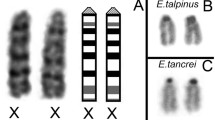Abstract
The origin of neo-XY sex systems in Acrididae is usually explained through an X-autosome centric fusion, and the behaviour of the neo-sex chromosomes has been solely studied in males. In this paper we analysed male and female Dichroplus vittatus. The karyotype comprises 2n = 20 chromosomes including 9 pairs of autosomes and a sex chromosome pair that includes a large metacentric neo-X and a small telocentric neo-Y. We compared the meiotic behaviour of the sex bivalent between both sexes. Mean cell autosomal chiasma frequency was low in both sexes and slightly but significantly higher in males than in females. Chiasma frequency of females increased significantly when the sex-bivalent was included. Chiasma distribution was basically distal in both sexes. Behaviour of the neo-XY pair is complex as a priori suggested by its structure, which was analysed in mitosis and meiosis of diploid and polyploid cells. During meiosis, orientation of the neo-XY is highly irregular; only 21% of the metaphase I spermatocytes show standard orientation. In the rest of cells, the alternate or simultaneous activity of an extra kinetochore in the distal end of the short arm (XL) of the neo-X, determined unusual MI orientations and a high frequency of non-disjunction and lagging of the sex-chromosomes. In females, the neo-XX bivalent had a more regular behaviour but showed 17% asynapsis in the XL arm which, in those cases orientated its distal ends towards opposite spindle poles suggesting, again, the activity of a second kinetochore. The dicentric nature and the unstable meiotic behaviour of the sex neo-chromosomes of D. vittatus suggest a recent origin of the sex determination mechanism, with presumable adaptive advantages which could compensate their potential negative heterosis. Our observations suggest that the origin of the neo-sex system was a tandem fusion of two original telocentric X-chromosomes followed by another tandem fusion with the small megameric bivalent and a further pericentric inversion of the neo-X. The remaining autosomal homolog resulted in the neo-Y chromosome.
Similar content being viewed by others
References
Balatti, C.E., 1992. Estudios citológicos sobre el origen de macro y microespermátidas en ortópteros. MSc Thesis. Misiones National University, 69 pp.
Barlow, B.R. & D. Wiens, 1976. Translocation heterozygosity and sex ratio in Viscum fischeri. Heredity 37: 27–40.
Cardoso, H. & A. Dutra, 1979. The Neo-X, neo-Y sex pair in Acrididae, its structure and association. Chromosoma 70: 323–336.
Charlesworth, B.W. & J.D. Wall, 1999. Inbreeding, heterozygote advantage and the evolution of neo-X and neo-Y sex chromosomes. Proc. R. Soc. Lond. B. 266: 51–56.
Cosen, R. & F.A. Sáez, 1974. Cariotipo y sistema Neo-X Neo-Y en Dichroplus vittatus (Orthoptera, Acrididae). Physis C. 33(87): 237–242.
Henríques-Gil, N., G.H. Jones, M.I. Cano, P. Arana & J.L. Santos, 1987. Female meiosis during oocyte maturation in Eyprepocnemis plorans (Orthoptera: Acrididae). Can. J. Genet. Cytol. 27: 84–87.
Hewitt, G.M., 1979. Orthoptera, Grasshoppers and Crickets, pp. 1–170 in Animal Cytogenetics 3. Insecta 1, edited by B. John. Gebrüder Borntraeger, Berlin-Suttgart.
John, B., 1983. The role of chromosome change in the evolution of Orthopteroid insects, pp. 1–110 in Chromosomes in the Evolution of Eukaryotic Groups. I, edited by A.K. Sharma and A.S. Sharma. CRC Press, Boca Ratón.
John, B., 1990. Meiosis. Cambridge University Press, Cambridge, pp. 1–396.
Lafuente, N. & R. Guerra, 1977. Citotaxonomía de cuatro especies de Dichroplus. An. Mus. Hist. Nat. Valparaíso 10: 205–210.
Martí, D.A. & C.J. Bidau, 1995. Male and female meiosis in a natural population of Dichroplus pratensis (Acrididae) polymorphic for Robertsonian translocations: A study of chiasma frequency and distribution. Hereditas 123: 227–235.
McClung, C.E., 1917. The multiple chromosomes of Hesperotettix and Mermiria. J. Morph. 29: 519–605.
Mesa, A., 1971. Cariología de tres especies de acridios del género Dichroplus (Orthoptera, Acrididae). Rev. Peru. Entomol. 14: 233–237.
Mesa, A., A. Ferreira & C.S. Carbonell, 1982. Cariología de los acridoideos neotropicales: estado actual de su conocimiento y nuevas contribuciones. Annls. Soc. Ent. Fr. (NS) 18: 507–526.
Mirol, P.M. & C.J. Bidau, 1992. Proximal chiasmata induce nondisjunctional orientation of Robertsonian trivalents in a grasshopper. Heredity 69: 268–278.
Perry, P.E. & G.H. Jones, 1974. Male and female meiosis in grasshoppers. I. Stethophyma grossum. Chromosoma 47: 475–482.
Rufas, J., 1985. Contribución de las técnicas de impregnación argéntica al estudio de los cromosomas de Ortépteros, pp. 227–255 in Orthoptera, Vol. 1, edited by J. Gosálvez., C. López Fernández and C. García de la Vega. Fundación Ramón Areces, Madrid.
Sáez, F.A., 1963. Gradient of the heterochromatinisation in the evolution of the sexual system ‘neo-X-neoY'. Port. Acta Biol. Ser. A 7: 111–138.
Smith, S.G. & N. Virkki, 1978. Coleoptera, pp 1–366 in Animnal Cytogenetics 3. Insecta 5 edited by B. John. Gebrüder Borntraeger, Berlin-Stuttgart.
Sybenga, J., 1975. Meiotic Configurations. Springer, Berlin, pp. 1–225.
White, M.J.D., 1973. Animal Cytology and Evolution. Cambridge University Press, Cambridge, 3rd edn, pp. 1–961
White, M.J.D., R.E. Blackith, R.M. Blackith & J. Cheney, 1967. Cytogenetics of the viatica group of Morabine grasshoppers. I. The ‘coastal’ species. Aust. J. Zool. 15: 263–302.
Author information
Authors and Affiliations
Rights and permissions
About this article
Cite this article
Bidau, C.J., Marti, D.A. Meiosis and the Neo- XY system of Dichroplus vittatus (Melanoplinae, Acrididae): a comparison between sexes. Genetica 110, 185–194 (2000). https://doi.org/10.1023/A:1017908213431
Issue Date:
DOI: https://doi.org/10.1023/A:1017908213431




